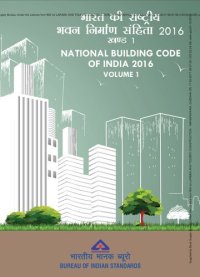
Ebook: National Building Code of India 2016 Volume 1
Author: BIS
- Genre: Technique // Construction: Ventilation and Air Conditioning
- Tags: India Building Code NBC Architecture
- Year: 2016
- Publisher: BIS
- City: NEW DELHI
- Language: English
- pdf
The National Building Code of India (NBC), a comprehensive building Code, is a national instrument providing guidelines
for regulating the building construction activities across the country. It serves as a Model Code for adoption by all
agencies involved in building construction works be they Public Works Departments, other government construction departments,
local bodies or private construction agencies. The Code mainly contains administrative regulations, development control rules
and general building requirements; fire safety requirements; stipulations regarding materials, structural design and
construction (including safety); building and plumbing services; approach to sustainability; and asset and facility management.
The Code was first published in 1970 at the instance of Planning Commission and then first revised in 1983. Thereafter three
major amendments were issued to the 1983 version, two in 1987 and the third in 1997. The second revision of the Code
was in 2005, to which two amendments were issued in 2015.
Due to large scale changes in the building construction activities, such as change in nature of occupancies with prevalence
of high rises and mixed occupancies, greater dependence and complicated nature of building services, development of new/innovative
construction materials and technologies, greater need for preservation of environment and recognition of need for planned management
of existing buildings and built environment, there has been a paradigm shift in building construction scenario. Considering these,
a Project for comprehensive revision of the Code was taken up under the aegis of the National Building Code Sectional Committee,
CED 46 of BIS and its 22 expert Panels; involving around 1 000 experts. As a culmination of the Project, the revised
Code has been brought out in 2016 as National Building Code of India 2016 reflecting the state-of-the-art and contemporary applicable international practices.
for regulating the building construction activities across the country. It serves as a Model Code for adoption by all
agencies involved in building construction works be they Public Works Departments, other government construction departments,
local bodies or private construction agencies. The Code mainly contains administrative regulations, development control rules
and general building requirements; fire safety requirements; stipulations regarding materials, structural design and
construction (including safety); building and plumbing services; approach to sustainability; and asset and facility management.
The Code was first published in 1970 at the instance of Planning Commission and then first revised in 1983. Thereafter three
major amendments were issued to the 1983 version, two in 1987 and the third in 1997. The second revision of the Code
was in 2005, to which two amendments were issued in 2015.
Due to large scale changes in the building construction activities, such as change in nature of occupancies with prevalence
of high rises and mixed occupancies, greater dependence and complicated nature of building services, development of new/innovative
construction materials and technologies, greater need for preservation of environment and recognition of need for planned management
of existing buildings and built environment, there has been a paradigm shift in building construction scenario. Considering these,
a Project for comprehensive revision of the Code was taken up under the aegis of the National Building Code Sectional Committee,
CED 46 of BIS and its 22 expert Panels; involving around 1 000 experts. As a culmination of the Project, the revised
Code has been brought out in 2016 as National Building Code of India 2016 reflecting the state-of-the-art and contemporary applicable international practices.
Download the book National Building Code of India 2016 Volume 1 for free or read online
Continue reading on any device:

Last viewed books
Related books
{related-news}
Comments (0)